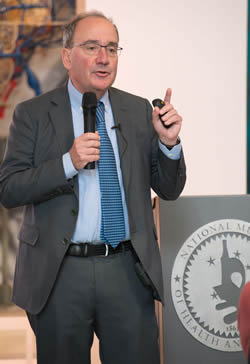Optimism Expressed in Curing Brain Diseases
By Daniel Daglis
National Museum of Health and Medicine
For centuries, society has been plagued by neurological diseases, burdening many with mental illness and causing some to have to sit by and watch loved ones suffer through neurodegenerative diseases such as Alzheimer's. Appropriately following the National Museum of Health and Medicine's (NMHM) Brain Awareness Week, the National Science Foundation's Assistant Director for the Directorate for Biological Sciences (BIO), Dr. Jim Olds, gave attendees an optimistic view of the path to finding a cure to brain diseases at the Tuesday, March 22, 2016 Medical Museum Science Café.
A key message Dr. Olds wants to make clear is, "If we don't understand the basic mechanisms of how the healthy brain operates, mechanistically we are going to have a very difficult time curing brain diseases."
Speaking in an NMHM exhibit gallery featuring traumatic brain injuries, Olds began the program discussing his training in the 1980s to demonstrate just how far scientists' understanding of the brain has come in recent decades. "In the field of neuroscience, in the 1980s, we had a lot of drugs that were available for a lot of brain diseases, ranging from schizophrenia to major depression – and even the first drugs for Alzheimer's. There were theories on how these diseases played out in the brains of humans. Unfortunately, the theories were wrong and the drugs didn't work."
Understanding how the brain works is no easy task. The complexity of the brain is unmatched by any known machine on Earth. As described by Olds, the human brain has 10 thousand billion computational elements, and it all runs on only 20 watts of power – which is about the same as a light you would find in a refrigerator. In recent years, neuroscientists made a breakthrough in identifying the brain's neural codes, which are binary codes that read similar to those of a computer.
"These codes can be used to explain, for example, why someone with schizophrenia hears audible voices that are not there," Olds said.
Identifying and understanding neural codes is just one step to curing brain disease. Olds pointed out other steps to innovation including the affordability of gene sequencing and the technologies that have become available such as axial tomography, which is a method of brain imaging that allows neuroscientists to see every single synapse of the brain.
In addition, Olds made the assertion that "We need to pool and standardize data; democratize it. Encouraging the sharing of data between laboratories would ultimately reduce the cost of research."
Olds' efforts to bring the neuroscience community together have proven beneficial. Brain disease became a top priority and garnered much needed support from the federal government in 2013, when Olds helped to shape President Obama's BRAIN Initiative, which has invested $50 million over the last year in advancing neuroscience.
"The administration has such a focus on brain initiatives because brain disease is damaging to public health as well as the economy," Olds said.
Given government support for brain research, the advances in technology which allow neuroscientists to study the brain closer than ever before, and the breakthrough of learning how to read and analyze neural codes, Dr. Olds says, "I believe we are poised to find a cure for brain diseases."
NMHM's Medical Museum Science Cafes are a regular series of informal talks that connect the mission of the Department of Defense museum with the public. NMHM was founded as the Army Medical Museum in 1862 and moved to its current location in Silver Spring, Maryland, in 2012. NMHM is an element of the Defense Health Agency. For more information on upcoming events, call 301-319-3303 or visit www.medicalmuseum.mil.

|
Caption:
The National Science Foundation's Assistant Director for the Directorate for Biological Sciences, Dr. Jim Olds, presents at the March 22, 2016 Medical Museum Science Café at the National Museum of Health and Medicine, Silver Spring, Maryland. The program was titled "Searching for an Elusive Cure to Brain Diseases." (National Museum of Health and Medicine photo by Matthew Breitbart / Released) |

|
Caption:
Dr. Jim Olds, the National Science Foundation's Assistant Director for the Directorate for Biological Sciences (standing at left), presents at the March 22, 2016 Medical Museum Science Café at the National Museum of Health and Medicine, Silver Spring, Maryland. The program was titled "Searching for an Elusive Cure to Brain Diseases." (National Museum of Health and Medicine photo by Matthew Breitbart / Released) |



